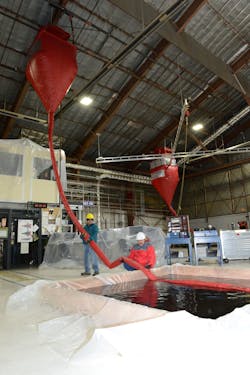Stress Test
Aircraft hangar fire suppression systems must be tested every two years to ensure the safety of hangar workers. Preparing for this test is a long, expensive process that can shut down a hangar for days. Steve Bridgers, JT4, JSF supervisor, Facility Engineering for Edwards Air Force Base and Mike Hudyma, president of SCS Interiors, solved this problem with an improved fire suppression system that is less expensive, less time-consuming and better for the environment.
Foam generators at the top of a hangar mix soap and water during a fire suppression test. Water pressure drives a mechanical fan that blows air across a diffuser. This creates foam that is dumped onto the hangar floor until the building is filled 15 to 20 feet high.
Preparing for this messy test requires airport hangar employees to tape plastic over all the hangar systems and power stations, which is a long and expensive process. Prepping a hangar in this manner takes many man-hours and hundreds of feet of plastic covers and duct tape.
“That would take an enormous labor to accomplish for a hangar that supports six jets. We estimated that flight operation would stop for a minimum of three to four days,” Bridgers commented, citing that Edwards Air Force Base has three hangars where this testing is conducted.
Bridgers came up with an idea to create fire suppression funnels which channel the fluid into containment ponds, saving the base time and money. The hangar does not need to be shut down to be prepped with plastic covers and duct tape. According to Mary Parker, deputy director for logistics, F-35 ITF at Edwards Air Force Base, using this method saves the base $79,750 per test.
How it Works
Bridgers and Hudyma designed the fire suppression funnels to fit over the foam generators and direct the liquid to 12-foot by 12-foot ponds made from two-inch by twelve-inch by twelve-foot boards assembled with hinges and pins. The foam generators dump the solution into the six-foot by six-foot funnels attached to an eight-inch wide, 35-foot long tube, which runs into the ponds, capturing the water.
The hoses are similar to high-pressure air hoses used to deliver conditioned air to an aircraft. The hoses are made of reinforced PVC fabric, “and the coating on that fabric when it’s heated and pressed together, it welds itself into one continuous tube,” Hudyma said. “They’re kind of the same concept, one’s delivering air, one’s delivering water.”
After the fire suppression test, an environmental company pump truck sucks the water out of the ponds and takes it away for safe disposal. This method requires minimal clean up when compared to the other testing method.
“Tear down the ponds, throw away the plastic, remove the funnels and ponds and store and move aircraft back into the hangars,” said Bridgers.
Firefighting foam — like what is used to test fire suppression systems — has been linked to harmful PFOS and PFOA contaminants in water sources.
For example, water sources for the city of Newburgh and Holloman Air Force Base tested positive for these chemicals in recent years, according to news reports.
These chemicals can cause several health complications. The use of Bridgers’ and Hudyma’s fire suppression testing system mitigates the risk of these chemicals contaminating the environment. The environmental companies pump the contaminated water out of the containment ponds and dispose of it at proper sites that meet environmental laws, Bridgers noted.
The fire suppression funnels are manufactured by SCS Interiors and can be purchased through BKW GSE. Bruce Warne, master distributor for the fire suppression testing system, consultant for commercial and military sales and owner of BKW GSE, said the system can be customized to fit any airport hangar needs.
“They can be custom ordered in any length that you need,” Warne said. “There’s no set number of feet because every hangar is different. So, if somebody needs 40 feet, that’s what I’ll do. If somebody needs 80 feet, I can do that. Or, if somebody needs 100 feet, that’s not a problem.”
The testing system can be for a four, six or eight position hangar, depending on the need.
“Bottom line is, what you can do with this is, just imagine a hangar that has 12 nozzles up at the top. Basically, on your testing, you can segregate those and do four at a time,” said Warne. This way, only one section of the hangar will be tested at one time. The system can come in any multiple of four, six or eight, allowing the customer to choose how many nozzles to test at one time.
The Test, Put to the Test
Edwards Air Force Base’s fire department was wary of the idea at first, Bridgers said. So, he had the firemen use the truck fire hose to spray 250 gallons per minute down the prototype to simulate a fire suppression dump.
After the initial test, Bridgers and Hudyma added a clear plastic window at the top of the hose. The water running out of the hose and into the containment ponds proved the fire suppression system worked. The clear plastic window allows the testers to see how the nozzle operates during the test.
“Is it coming out in a straight jet or is it coming out in a fan when you’re washing your car?” Hudyma remarked.
After adding a clear plastic window at the top of the hose, Edwards Air Force Base started using this fire suppression testing system in their airport hangars.
The system is currently being used at the F-35 flight test program at Edwards Air Force Base. The F-22 program has also borrowed the funnel system to perform their fire suppression tests.
